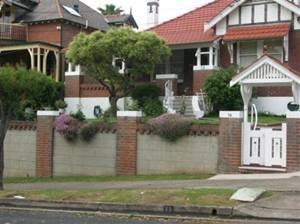- Residents
-
Community
-
Community services
-
Facilities & venues
-
Get involved
-
Parking & transport
-
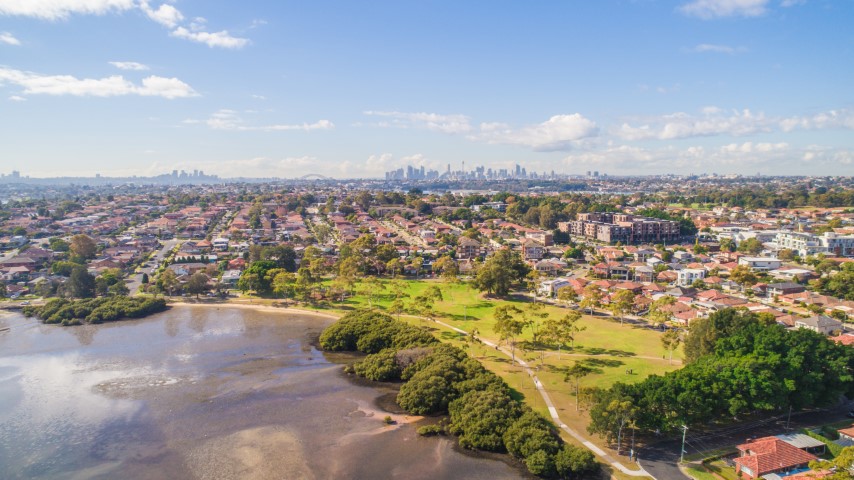 Help plan the City of Canada Bay's future and steer decisions on issues that matter to you.Share your feedback Collaborate Canada Bay
Help plan the City of Canada Bay's future and steer decisions on issues that matter to you.Share your feedback Collaborate Canada Bay
-
Community services
- Lifestyle
-
Business
- Development
- Council
Fencing styles
Breadcrumb
- City of Canada Bay Council
- Development
- Heritage
- Fencing styles
Fencing is one of the most important elements in the presentation of your house. The design of your fence should complement the style of your house. This can be achieved by building your fence of materials and colours that relate to the materials and colours used in the house.
Fence design changes with different architectural periods and styles. If you are lucky enough to have early photographs of your house, these might provide valuable clues for the original design of the fence that was built for your house. A general guideline of the most common types of fencing found in the City of Canada Bay for different house styles is given below:
|
Style |
Fence type |
|---|---|
|
Victorian Cottage |
Timber picket |
|
|
Woven wire |
|
Victorian Italianate |
Iron palisade |
|
Victorian Gothic |
Iron palisade up to 1200mm high |
|
|
Timber picket fence up to 900mm high |
|
|
Woven wire |
|
Federation |
Masonry pier and panel |
|
|
Timber Picket (square topped) |
|
|
Solid masonry |
|
|
Woven wire |
|
|
Brick pier and panel |
|
Inter-War |
Solid masonry |
|
|
Woven wire |
Please view fence styles below or download a copy of Council's Types of Fencing Fact Sheet.
Please note that properties that are listed as heritage items or are located in conservation areas may be required to lodge an application for Maintenance and Minor Work prior to constructing a new fence.
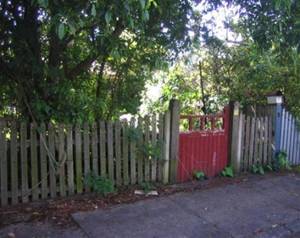
Timber picket fences are built with timber pickets fixed to horizontal rails spanning between posts. The spacing of the pickets is usually the same as the width of the picket.
The pickets for fences to Victorian houses usually have a shaped top. Common shapes for pickets in Victorian fences include pointed, half round, and acorn. Picket fences for Federation houses are more likely to have square tops and chamfered edges. Posts for picket fences are often shaped in a design that relates to the shape of the pickets. Federation period houses might also have pickets combined with brick piers and low brick panels.
Gates for picket fences are made of either matching pickets or might be framed with boarded timber panels.
The height of picket fences varies from 900 to 1200 mm high, usually depending on the length of the street boundary.
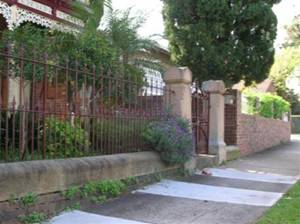
Palisade fences have panels of cast iron pickets, with spiked or shaped tops, connected by a horizontal rail and set into a sandstone or rendered masonry base. Dressed sandstone posts are located at corners and gateways and, where necessary, intermediate posts are used.
Palisade fences are usually between 1200 and 1500 mm high. On some larger sites, a palisade fence could be up to 1800 mm high.
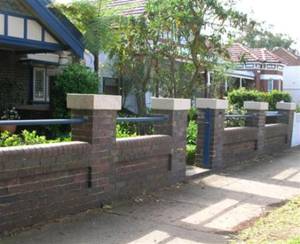
Masonry pier and panel fences are found with both Federation and Inter-War period houses. They are usually built with low panels of face brickwork between brick piers up to 900 mm high. A single pipe rail or panel of wrought metalwork spans between the brick piers. On some sites, sandstone is used instead of face brick.
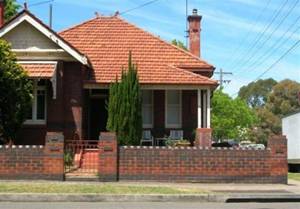
Solid masonry fences are designed with panels of solid masonry up to 900 mm high between slightly taller piers. The materials are usually face brick or sandstone, depending on the materials used in the design of the house.
Solid masonry fences are usually much lower for Inter-War and Post WWII housing with panels up to 450 mm high.
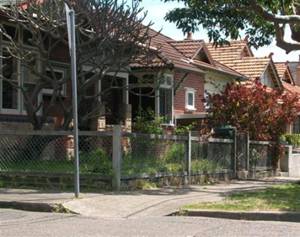
Variations of woven wire fencing were used in most periods. Wire mesh was fixed to a simple frame of post and rails to provide a simple fence. Earlier examples are rare and often have the wire finished in decorative loops at the top. Later examples use chain wire with timber framing. Privacy was usually achieved by planting a hedge behind the wire mesh. Woven wire fences are rarely more than 900 mm high.

